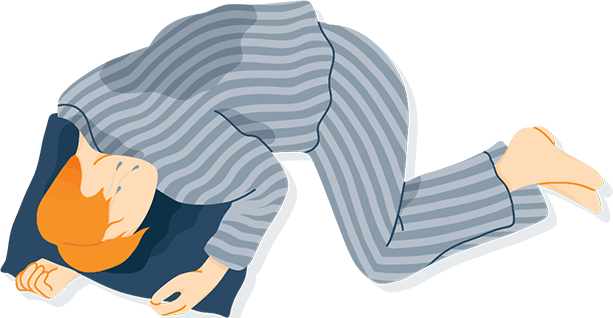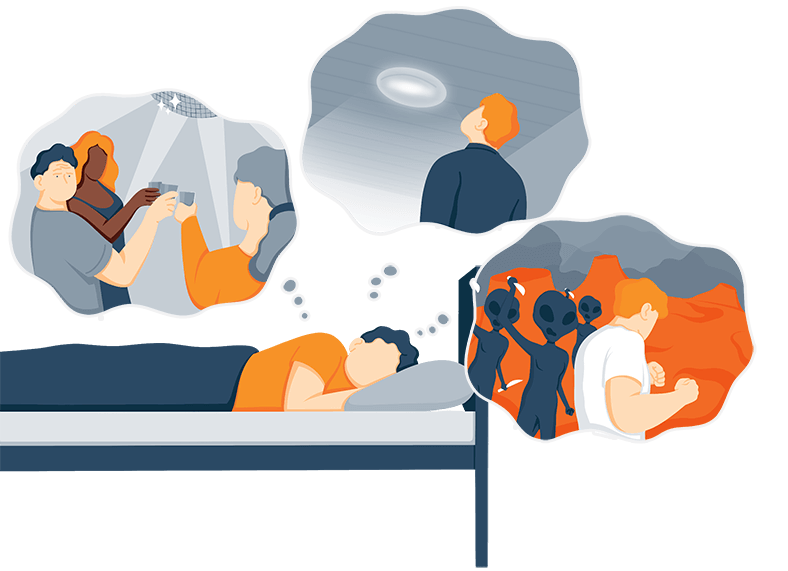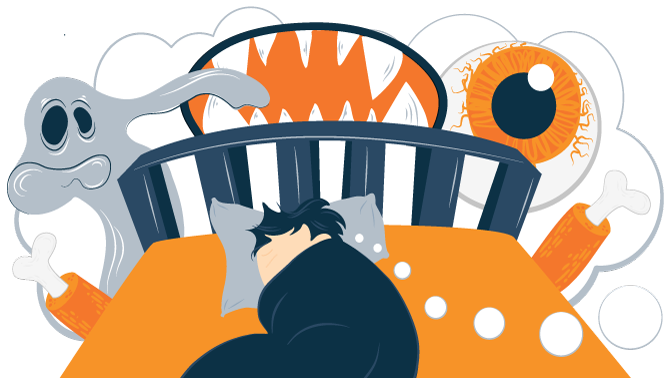If you’ve ever woken up and couldn’t move your limbs for brief period of time, you may have experienced sleep paralysis. This phenomenon is a type of parasomnia — or strange nighttime occurrence — that, understandably, may have you concerned about what it is and what it means.
We’re here to help take the mystery out of this topic by diving into everything you need to know about sleep paralysis. We’ll cover why it happens, the different types, and ways to help prevent it.
What Is Sleep Paralysis?
Sleep paralysis is a widely mysterious but medically recognized condition that blurs the boundary between wakefulness and sleep. Sleep paralysis is classified as the temporary inability to move, typically occurring soon after falling asleep or waking up1. According to Dr. Heidi Moawad, an experienced neurologist, this condition is not harmful. Dr. Moawad adds, “Some people have recurrent episodes, but most people recall having a few episodes throughout their whole lifetime.”
People who experience one or more of these episodes remain aware of what’s happening as they experience this “frozen” sensation. In some cases, these accounts could be paired with disturbing hallucinations.1
While there remains an abundance to learn about the condition, understanding types, causes, symptoms, personal accounts, and prevention strategies could help you gain more insight into how to treat your issue.
Types of Sleep Paralysis
Hypnagogic sleep paralysis happens as you’re drifting off to sleep2. In normal sleep, people become less and less aware, eventually falling into the first non-REM stage of sleep. However, during an episode of hypnagogic sleep paralysis, your mind is aware while your body is in a paralytic state.
Hypnopompic sleep paralysis occurs when you’re waking up; your mind becomes awake before your muscles are “switched on” as you near the end of your REM sleep cycle.
Symptoms of Sleep Paralysis
Symptoms of a sleep paralysis episode include a brief loss of muscle control during the night. In normal sleep, this loss of muscle movement will occur during REM sleep, but we are usually unaware of this. In the case of a sleep paralysis episode, though, we experience conscious wakefulness while in this state of temporary paralysis.1
Other symptoms of a sleep paralysis episode may include:
- Inability to speak3
- Hallucinations1

If you are someone who has experienced any of these symptoms as a result of this condition, it’s normal to feel frightened. Fortunately, sleep paralysis episodes are largely temporary, typically lasting a few seconds to a few minutes4. Understanding why and how this occurs, which we explain below, could be helpful in managing anxiety or fear when episodes strike.
Why Does Sleep Paralysis Occur?
Normal Sleep vs. Sleep Paralysis
A regular sleep cycle will include phases of REM sleep and non-REM sleep. When you’re first drifting off, you experience non-REM, which consists of three stages. As you move through each phase, your breathing grows more rhythmic, and you’re less likely to wake up5 from disturbances.
After you’ve moved through the non-REM stages, you enter REM (rapid-eye movement) sleep, which is when dreams occur. A neurotransmitter called glycine is released into your body during the REM stage. The glycine puts you into a temporary state of paralysis, though critical involuntary muscles, like your diaphragm for breathing, remain active.5
The eyes normally move during the REM dreaming phase, which stands for rapid eye movement. In some cases, people can communicate with their eyes during sleep paralysis episodes.

The Brain During Sleep Paralysis
As mentioned, sleep paralysis can occur as you are falling asleep or waking up.1
REM sleep is particularly relevant to this condition because this is the stage when we dream and our brains are most active. Brain activity during this stage is often significantly lively compared to non-REM stages, and your brain waves on an EEG study will appear almost as though you’re awake.
In this mentally active stage, to protect ourselves from acting out whatever is occurring in our dreams, our bodies incite paralysis using glycine. Sleep paralysis happens when there’s a transitional disruption between REM sleep and consciousness, making it so you’re at least semi-conscious, but the protective paralysis prevents movement or has yet to subside.
Learn more: Stages of Sleep
Common Sensations of Sleep Paralysis
Earlier we mentioned that people may experience hallucinations from sleep paralysis.1 People can experience these hallucinations6 either from wakefulness to sleep (hypnagogic hallucinations) or from sleep to wakefulness (hypnopompic hallucinations). These confusing experiences can feel like vivid dreams or frightening realities.
Causes of Sleep Paralysis
According to experts, the cause of sleep paralysis is not yet known, though they say it could be linked to certain risk factors1:
- Sleep deprivation
- Changes in your sleep schedule
- Stress
- Sleeping on your back
- Narcolepsy
- Bipolar disorder
- Post-traumatic stress disorder (PTSD)
- Panic disorder
- Taking certain medications, particularly treatments for ADHD
- Substance abuse
According to the American Academy of Sleep Medicine, some experts believe that genetics play a role, so if you have a family member who experiences symptoms, you might as well.4 Sleep paralysis can strike any person at any age, but the first symptoms are usually seen between the ages of 14 and 17 years old. However, research is still inconclusive regarding the percentage of the population in which it afflicts. Estimates vary between 5 and 40 percent. 4
Is Sleep Paralysis Serious?
Sleep paralysis could cause anxiety, but it is not a severe risk. However, it can happen concurrently with other disorders like narcolepsy, which is a sleep disorder that impacts the brain’s ability to manage sleep-wake cycles7.
According to the National Institute of Neurological Disorders and Stroke, narcolepsy commonly begins between the ages of 7 and 25, but it can occur throughout the person’s life.7
Sleep Paralysis Prevention and Treatment
As mentioned, some of the causes of sleep paralysis can include sleep loss, an irregular sleep schedule, sleeping on your back, and stress.1
So, to help manage sleep paralysis, try focusing on the following methods:
- Prioritizing good sleep hygiene habits to improve sleep quality
- Going to bed and waking up at the same time each day
- Managing stress
- Sleeping on your side or stomach instead of your back
Keep in mind that if your condition is severe, or you’re concerned your episodes could be linked to an underlying health condition, seeking professional treatment is always essential.
When treatment is necessary, it’s typically aimed at the root of the issue. If you’re sleep-deprived, you may require more rest as well as regular bedtimes and wake times.
Psychiatric problems can also trigger sleep paralysis, such as bipolar disorder.1 In this case, a professional would need to oversee treatment. Additionally, certain sleep disorders, such as narcolepsy, are linked to sleep paralysis, and these people may require medication to treat their narcolepsy.1
Accounts of Sleep Paralysis Demons and Evil Presences
Similar to how sleep paralysis happens when there’s a disruption in the transition between sleep stages, it’s also possible to have your sleep cycle interrupted in a way that you interpret dream-like hallucinations as actual occurrences.
According to Wexner Medical Center, some researchers attribute personal accounts of alien abduction or ghostly demons to these hallucinations.5

Many cultures contain historical accounts of these sleep paralysis “demons.” According to the American Academy of Sleep Medicine8, a 17th-century Dutch physician reported about a woman with sleep paralysis with the statement, The devil lay upon her and held her down.” They add that there have been accounts in Newfoundland, Japan, China, and Mexico — each with their own name or description for this occurrence.

Rachael Gilpin
Content Writer
About Author
Rachael is a content writer for Sleep Advisor who loves combining her enthusiasm for writing and wellness.
Back Sleeper
References:
- “Sleep paralysis”. Medline Plus. Last modified April 20, 2023.
- D’Agostino MD, Armando., Limosani MD, Ivan. “Hypnagogic Hallucinations and Sleep Paralysis”. Narcolepsy. 2016.
- Restivo, Jenette. “Sleep paralysis: Causes, symptoms, and treatments”. Harvard Health. 2023.
- “What is sleep paralysis?”. American Academy of Sleep Medicine. 2020.
- Das MD, Aneesa. “What’s Happening to the Body during Sleep Paralysis?”. The Ohio State University Wexner Medical Center. 2018.
- Waters, Flavie., et al. “What Is the Link Between Hallucinations, Dreams, and Hypnagogic-Hypnopompic Experiences?”. Schizophrenia Bulletin. 2016.
- “Narcolepsy”. National Institute of Neurological Disorders and Stroke. Last modified November 28, 2023.
- “Sleep paralysis: The devil, the ghost & the old hag”. American Academy of Sleep Medicine. 2009.
